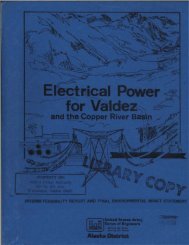Before the FERC Application for New License for the Annex Creek ...
Before the FERC Application for New License for the Annex Creek ...
Before the FERC Application for New License for the Annex Creek ...
You also want an ePaper? Increase the reach of your titles
YUMPU automatically turns print PDFs into web optimized ePapers that Google loves.
B-7<br />
Dur i ng adverse water years, when <strong>the</strong> reservoi r 1 eve 1 drops be 1 ow<br />
<strong>the</strong> minimum pool, only minimum releases <strong>for</strong> fisheries and municipal water<br />
supply will be made.<br />
3.2 ANALYSIS OF ESTIMATED DEPENDABLE<br />
CAPACITY AND AVERAGE ANNUAL ENERGY<br />
General Methodology. The methodology used to estimate dependable capacity<br />
and average annual energy of <strong>the</strong> Salmon <strong>Creek</strong> facility is <strong>the</strong> same as that<br />
described previously <strong>for</strong> <strong>Annex</strong> <strong>Creek</strong> in Section 2.2.<br />
Streamflow Hydrology, Reservoir Inflow and Inflow Duration Curve. No<br />
long term record of unregulated Salmon <strong>Creek</strong> streamflows is available.<br />
Streamf10ws were recorded at <strong>the</strong> present site of Sa 1 mon <strong>Creek</strong> Dam from May<br />
1911 through April 1914. Also, runoff in <strong>the</strong> Salmon <strong>Creek</strong> flume below <strong>the</strong><br />
Upper Powerhouse was recorded from October 1914 through September 1917.<br />
Streamflows were recorded at <strong>the</strong> present site of Sa 1 mon <strong>Creek</strong> Dam <strong>for</strong> a<br />
23-month per i od . Due to <strong>the</strong> 1 i mi ted extent of th iss treamf1 ow record, syn<strong>the</strong>tic<br />
flow records were developed by <strong>the</strong> App1 icant <strong>for</strong> Salmon <strong>Creek</strong>. The<br />
syn<strong>the</strong>tic monthly average inflows are based on 22 years of gaged streamflow<br />
records from local basins with similar characteristics, namely Sheep <strong>Creek</strong>,<br />
Gold <strong>Creek</strong>, and Carlson <strong>Creek</strong>. Relationships between <strong>the</strong>se basins and Salmon<br />
<strong>Creek</strong> were established based on <strong>the</strong> period 1914 through 1920, where streamflow<br />
records <strong>for</strong> a 11 four sites are ava i 1 ab 1 e. Sheep <strong>Creek</strong> resu1 ted in <strong>the</strong> best<br />
correlation and was primarily used to develop <strong>the</strong> Salmon <strong>Creek</strong> streamf10ws.<br />
The 22-year study period January 1940 through December 1961 was<br />
selected as <strong>the</strong> critical study period because it includes <strong>the</strong> driest 2-year<br />
period on record, January 1950 through December 1951. Since Sheep <strong>Creek</strong> runoff<br />
records are only available <strong>for</strong> water years 1947 through 1962, <strong>the</strong> runoff<br />
from January 1940 through September 1946 was developed using a correlation<br />
with precipitation at Juneau. Using <strong>the</strong> actual and syn<strong>the</strong>tic Sheep <strong>Creek</strong><br />
streamf10ws, <strong>the</strong> Salmon <strong>Creek</strong> streamflows were developed <strong>for</strong> <strong>the</strong> 22-year critical<br />
study period. The complete methodology used is documented in "Feasibility<br />
Study - Replacement of Salmon <strong>Creek</strong> Flume and Lower Powerhouse Penstock,1I<br />
James M. Montgomery, Consulting Engineers, Inc., 1980.<br />
Based on <strong>the</strong> syn<strong>the</strong>tic streamflow record, <strong>the</strong> average unregulated<br />
inflow to Salmon <strong>Creek</strong> Reservoir is approximately 63 cfs. The maximum monthly<br />
average i nfl ow i s 227 cfs, and <strong>the</strong> mi n i mum month 1 y average i nf1 ow i s 0 cfs.<br />
An inflow duration curve <strong>for</strong> Salmon <strong>Creek</strong> Reservoir is shown in Fig. 8-4.<br />
Reservoir Rule Curve, Downstream Flow Requirements and Area-Capacity<br />
Curve. The power operations study was based on a rule curve release schedule<br />
designed to maximize power generation during <strong>the</strong> critical winter months of<br />
December through Apri 1 . For Sa 1 mon <strong>Creek</strong> Reservoi r, <strong>the</strong> ru 1 e curve re 1 eases<br />
were as follows:

















